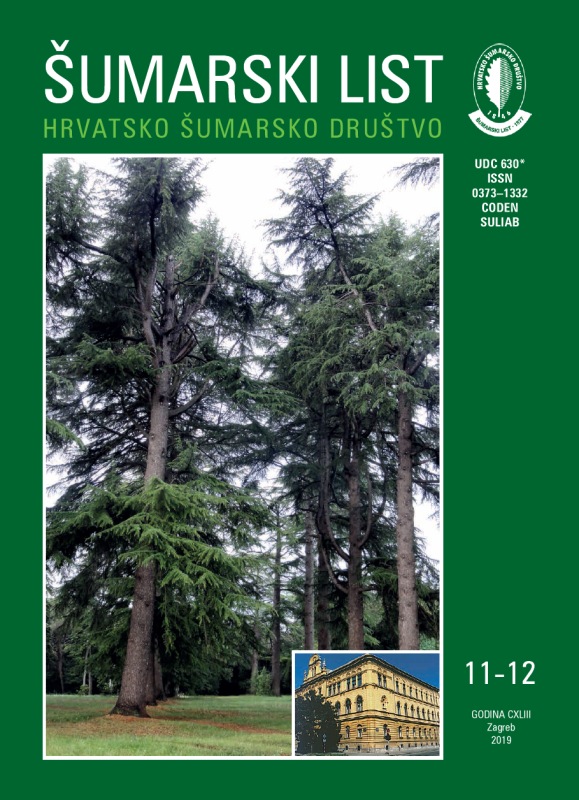
broj: 11-12/2019
pdf (10,71 MB) |
|
||||||||||||||
| RIJEČ UREDNIŠTVA | ||
| Uredništvo | ||
| Should the national forestry policy and strategy be modernized? pdf HR EN | 513 | |
| IZVORNI ZNANSTVENI ČLANCI | ||
| Jurij Marenče, Marijan Šušnjar | UDK 630* 375 (001) https://doi.org/10.31298/sl.143.11-12.1 | |
| Limiting forces and load masses during timber winching pdf HR EN | 515 | |
| Ivan Lukić, Željko Zgrablić, Vlatka Mičetić Stanković | UDK 630* 453 (001) https://doi.org/10.31298/sl.143.11-12.2 | |
| Presence of birch bark beetle (Scolytus ratzeburgi) in Croatia pdf HR EN | 523 | |
| Stjepan Kvesić, Dalibor Ballian, Mirzeta Memišević Hodžić | UDK 630* 164 (001) https://doi.org/10.31298/sl.143.11-12.3 | |
| Population variability of field maple (Acer campestre L.) in Bosnia and Herzegovina according to the fruit morphology pdf HR EN | 529 | |
| Deniz Güney, Zeki Yahyaoglu, Ali Bayraktar, Fahrettin Atar, Ibrahim Turna | UDK 630* 165 (001) https://doi.org/10.31298/sl.143.11-12.4 | |
| Genetic diversity of Picea orientalis (L.) Link populations in Turkey pdf HR EN | 539 | |
| Summary Knowledge of genetic variation is needed to understanding the genetic structure in forest tree populations. In addition, the determination of the genetic structure in the natural distribution areas of forest trees has become easier depending on the development of the isoenzyme technique. Determining the genetic structure and variations of Picea orientalis (L.) Link, which is limited local natural distribution areas on the world, transfer of this genetic to the future generations with sustainable forestry is important to ensure the continuity of the species. In this study, genetic differences and similarities were determined for P. orientalis populations in selected regions (Artvin, Torul-Örümcek, Tirebolu-Akılbaba, Ordu-Çambaşı, Artvin-Şavşat, Ardanuç-Ovacık, Şavşat-Sahara, Artvin-Saçinka, Ardahan-Posof and Maçka-Hamsiköy) in Turkey. In the study using 10 gene loci in different enzyme systems to determine the genetic variation, the values of heterozygosity (Ho), number of alleles per locus (AL), genetic diversity (v), intrapopulational differentiation (dT), multilocus diversity (Vgam) and differentiation among populations (Dj) were determined in these populations. The grand means were obtained as 0.154, 1.74 and 1.719 for the observed heterozygosity, alleles per locus and genetic diversity, respectively. Moreover, when the genetic diversity was considered, three different groups arose in terms of selected populations. Since Torul-Örümcek population had relatively higher results in contrast to other populations, this population has high importance for sustainability of gene resource of oriental spruce. Key words: Genetic diversity; conservation; Isoenzyme; Picea orientalis | ||
| PREGLEDNI ČLANCI | ||
| Ilija Đorđević, Nenad Ranković, Jelena Nedeljković, Jelena Tomićević-Dubljević, Dragan Nonić, Stjepan Posavec, Goran Češljar | UDK 630* 934 + 676 (001) https://doi.org/10-31298/sl.143.11-12.5 | |
| Mechanisms of financing the protected area management system in Serbia pdf HR EN | 549 | |
| PRETHODNO PRIOPĆENJE | ||
| Nikica Ogris, Tine Hauptman, Maarten de Groot, Dušan Jurc | UDK 630* 270 + 305 https://doi.org/10.31298/sl.143.11-12.6 | |
| Comparison of two methods for monitoring urban forests health pdf HR EN | 561 | |
| Ivan Pervan, Tena Radočaj, Tea Tomljanović, Miljenko Bujanić, Dean Konjević | UDK 630* 134 https://doi.org/10.31298/sl.143.11-12.7 | |
| Determination of sex and morphological characteristics of fat dormouse (Glis glis) from the area of Dalmatian hinterland pdf HR EN | 571 | |
| STRUČNI ČLANCI | ||
| Damir Drvodelić, Milan Oršanić | UDK 630* 232 https://doi.org/10.31298/sl.143.11-12.8 | |
| Selecting high quality forest seedlings of narrow-leaved ash (Fraxinus angustifolia Vahl) for regeneration and reforestation purposes pdf HR EN | 577 | |


